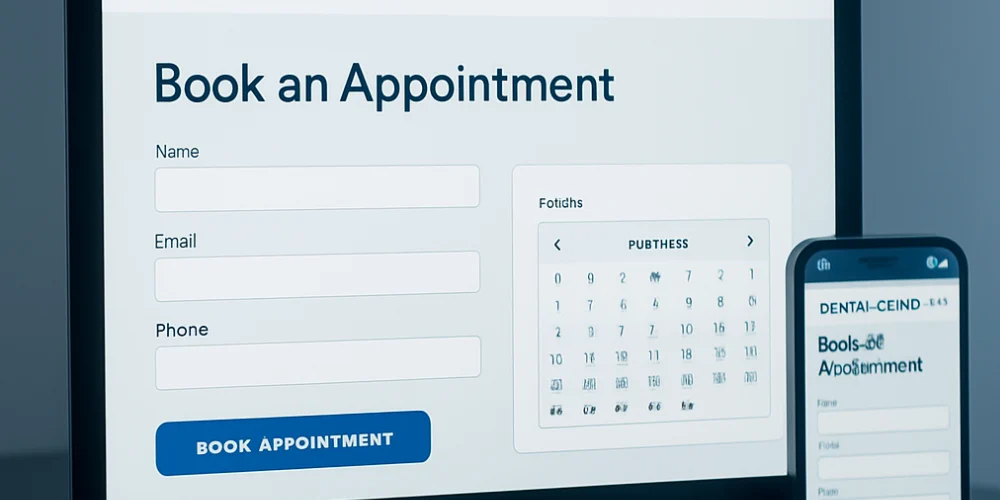December 26, 2025
12 min
Discover how to balance data privacy with effective analytics in dental practices while ensuring compliance and building patient trust.
August 21, 2025
12 minutes
Small dental clinics win by converting leads into loyal patients. Fast responses, CRMs, AI tools, and smart follow-ups cut missed calls, boost trust, and drive lasting growth.

A small dental clinic exists in a world where every inquiry, every patient call or web visit, is a chance. Most clinics focus on the immediate goal: get more leads. But in reality, the bottleneck is almost always in how those leads are converted or lost. The art of turning passing interest into loyal, recurring patients is not just about marketing – it’s the foundation on which small clinics can build real, sustained financial health.
Optimizing Digital Presence
The internet changed everything about how patients choose a clinic, especially at the neighborhood level. SEO and Google My Business aren’t just buzzwords — they’re the interface through which nearly every new patient will find you first. A well-tuned Google My Business listing (current info, good reviews, clear hours and address) means your practice rises above the noise, even for people searching just a block away. If your website is slow, clumsy, or doesn’t put a bold “Book Appointment” button front and center, you’re leaking leads from the start. In today’s world, mobile is not optional; your site — and every scheduling tool — has to work perfectly on a phone.
Leveraging Digital Marketing
Modern clinics use digital marketing as a targeting arrow, not a shotgun. Smart PPC campaigns, pointed at people searching for “emergency dentist near me” or “affordable Invisalign,” pick up the customers you want most. But ads alone aren’t enough; content (clear blog posts, helpful videos, honest testimonials) teaches patients before they walk in, which translates into trust. That trust, accumulated over a long period, is the real moat for a small practice.
Utilizing CRM Systems
For most clinics, patient communication and admin are unsung pain points. A good CRM, even a simple one like Nimble, quietly does the heavy lifting. Modern dental lead tracking CRM solutions allow practices to manage patient journeys seamlessly and improve appointment conversions. By automating reminders and nudging staff for follow-ups, it dramatically reduces the “leakage” of leads who slip through the cracks. When you sync scheduling, recall, and communications all in one stack, you liberate not just staff attention but mindshare: the front desk isn’t hunting for paperwork. That’s how you scale good patient experiences without scaling headaches.
Enhancing Lead Management with ConvertLens
Specialized tools — think ConvertLens — push the envelope further. These aren’t just generic CRMs; they’re built to track every step between inquiry and conversion, reporting (in clear dashboards) what each campaign is costing and which are actually working. When you can see in real time how each ad dollar or SEO tweak translates into booked appointments, the black box of marketing suddenly has a light. Plus, these systems often sync directly with the practice management platforms you already use, so you don’t double-handle data or drown your staff in manual updates. With features such as customizable marketing workflows, these tools align campaigns with patient behavior, ensuring inquiries turn into booked visits efficiently.
If there’s a universal law in patient conversion, it’s this: speed matters. The faster you respond to a patient inquiry, the more likely you are to land them. In busy clinics, most leads evaporate not from lack of demand, but from slow or missed responses. The clock is your main competitor.
Importance of Quick Responses
If response time is measured in minutes (not hours), conversion rates soar. Patients “shop” — they won’t wait, and if you don’t get to them while they’re still motivated, someone else will. Clinics that train their team or automate quick responses always see a revenue difference.
Centralized Call Handling Systems

Imagine every call, chat, or message across all locations funneled into one system — not scattered sticky notes and separate phone lines. Centralized call handling solves this. Clinics that connect every location, and every potential new patient, under one responsive team make for a smoother, more professional patient experience. And when you bake in analytics — using AI to parse what calls are about and where the friction is — you learn, fast, where systems break down.
AI-Driven Solutions
Where AI changes the game is routine: instantly answering basic questions, auto-scheduling appointments, and flagging urgent cases for human attention. When no lead gets lost in the heap, and you always know which need a nudge, conversion rates can jump by 50%—not magic, just systems working as intended.
When clinics adopt centralized call handling and AI triage, the data speaks: faster responses equal more bookings. One survey showed that just shrinking response time, coupled with tailored engagement (“Hi, Jane, saw you’re interested in cleaning—need help booking?”), materially increased patient appointments. The edge here isn’t just efficiency. It’s signaling you’re paying attention in a landscape where most don’t.
Basically, if you want more conversions, outpace your competitors at the moment when the patient’s actually reaching out. That’s where technology gives small clinics a fighting chance.
1) Customized Email Campaigns:
2) Personalized Patient Interactions:
1) Conversion Rate: The percentage of inquiries that schedule appointments. For most dental websites this is 2–5%, but elite clinics can do better — often because they sweat the details others ignore.
2) ROI on Marketing: The ratio of new business gained to what you spend on marketing. If you can’t measure this, you’re flying blind. The point isn’t to spend less, but to spend where it actually works.
3) Lead Source Effectiveness: Which sources — Google Ads, SEO, or patient referrals — bring the best leads? Without this, you’re ceding strategic advantage to anyone willing to check the data.
4) Appointment No-Show Rate: The forgotten metric - how many book but don’t show? If you don’t fix this with reminders and easy rescheduling, your numbers will lie.
The right analytics tool, like ConvertLens, actively connects these metrics to your real business. Tools with unified data dashboards integrate appointments, cancellations, and campaign spend into one view. If your dashboard auto-syncs with the systems you already use — pulling in appointments, cancellations, source of leads — you spend less time on paperwork and more on strategy. This is what lets a small practice punch above its weight.
If you don’t adapt your metrics, the world will shift beneath your feet. Every time patient behavior changes, every time a new marketing channel comes online, you need to reevaluate. Regular review and rapid adjustment, powered by real data from tools like ConvertLens, makes the difference between clinics that thrive and those that just get by.
Metrics tell the real story: not just where you are, but where you’re heading. Done right, they’re a crystal ball, letting you spot which levers to pull next in your conversion machine.
Ask anyone who’s built something lasting in the dental world, and you’ll hear the refrain: the difference isn’t always in chair-side manner, but in how well you understand, track, and nudge your leads. The formula is tailored strategies plus relentless measurement.
What ties this all together? Having the right tools, like ConvertLens, to reduce the time between learning something and acting on it. As competition climbs, the clinics that move first and measure hard will win not just now, but year after year.
Every missed call is more than just a lost appointment; it’s a lost first impression. In a saturated market, that’s the difference between a full book and empty chairs. Centralized call centers — supercharged by AI — are the answer. These systems instantly route and answer calls, track which go unanswered, and can even analyze call transcripts to spot opportunity or friction.
Underbooked slots are silent killers for growth. If your system makes it hard for patients to find and confirm a time, they’ll drift somewhere else. Automated scheduling isn’t just a fancy widget—it’s an essential part of converting leads when interest is high and attention fragile.
Leaning on these technologies, clinics can focus on patient care instead of chasing paperwork and messages, which leads, naturally, to more growth and happier patients.
The competitive landscape won’t get any less crowded. For small clinics, the difference between stagnation and growth is rarely about marketing alone, but about ceaselessly refining the path from inquiry to recurring patient. Technology like ConvertLens is how modern clinics get leverage, turning every lead into a genuine opportunity. The successful clinics will be those that never stop measuring, never stop tweaking, and never stop following up.
1. What is lead conversion in the context of a dental clinic?
Lead conversion refers to the process of turning potential patients (leads) into actual patients through effective communication, follow-ups, and addressing their dental needs and concerns.
2. How can a small dental clinic improve its lead conversion rates?
A small dental clinic can improve lead conversion rates by implementing an online appointment booking system, providing excellent customer service, promptly following up with leads, and offering promotions or educational content that addresses the patients' needs.
3. What role does online presence play in lead conversion for a dental clinic?
An online presence helps potential patients find the clinic easily, learn about services offered, read reviews, and initiate contact, all of which contribute to higher lead conversion rates.
4. How important is follow-up in the lead conversion process?
Follow-up is critical in the lead conversion process, as timely and personalized communication can significantly increase a lead's likelihood of booking an appointment and becoming a loyal patient.



Sign Up Now & Someone from Our Team Will Be in Touch Shortly!
Use the form below to send us a message, and we’ll get back to you as soon as we can.